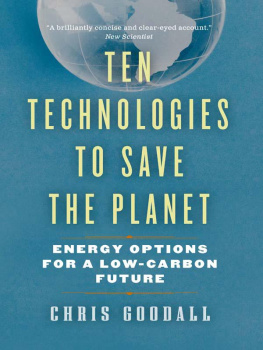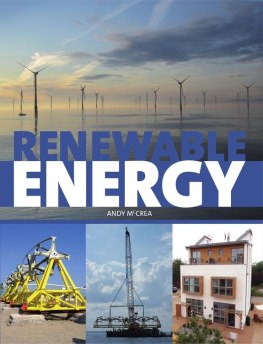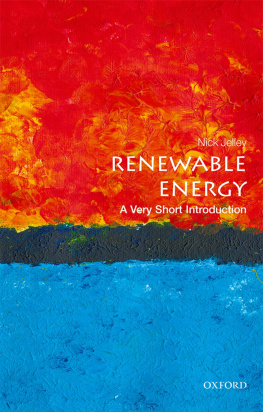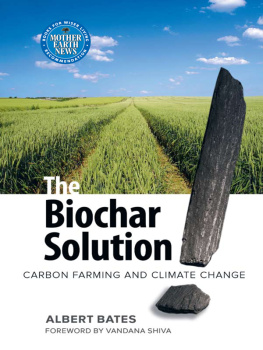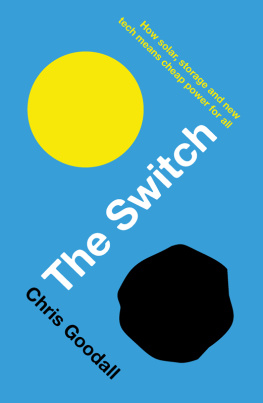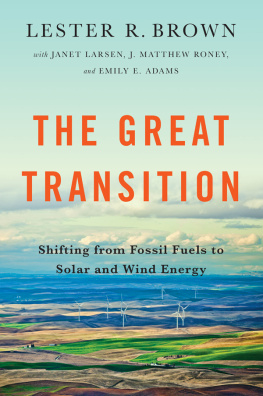Ten Technologies to Save the Planet

ENERGY OPTIONS
FOR A LOW - CARBON
FUTURE

CHRIS GOODALL
TEN
TECHNOLOGIES
TO SAVE
THE PLANET

GREYSTONE BOOKS
D& M PUBLISHERS INC.
Vancouver/Toronto/Berkeley
Copyright 2008, 2010 by Chris Goodall
10 11 12 13 14 5 4 3 2 1
All rights reserved. No part of this book may be reproduced, stored in a retrieval system or transmitted, in any form or by any means, without the prior written consent of the publisher or a license from The Canadian Copyright Licensing Agency (Access Copyright). For a copyright license, visit www.accesscopyright.ca or call toll free to 1-800-893-5777.
Greystone Books
An imprint of D&M Publishers Inc.
2323 Quebec Street, Suite 201
Vancouver BC Canada V5T 4S7
www.greystonebooks.com
First published in Great Britain in 2008 by GreenProfile,
an imprint of Profile Books Ltd. (London)
Library and Archives Canada Cataloguing in Publication
Goodall, Chris
Ten technologies to save the planet / Chris Goodall. Canadian ed.
Includes index.
ISBN 978-1-55365-525-1
1. Greenhouse gas mitigationTechnological innovations. I. Title.
TD885 .5 . G73G663 2010 363.738 746 C2009 - 906360 -3
Copy editing by Iva Cheung
Cover design by Ingrid Paulson
Text design by Naomi MacDougall
Printed and bound in Canada by Friesens
Printed on acid-free, FSC -certified, 100% post-consumer paper
Distributed in the U.S. by Publishers Group West

To my father and mother
1 CAPTURING THE WIND
Clean power thats more reliable than youd think
2 SOLAR ENERGY
Enough to power the world many times over
3 ELECTRICITY FROM THE OCEANS
Tapping tides, waves, and currents
4 COMBINED HEAT AND POWER
Fuel cells and district heating
5 SUPER-EFFICIENT HOMES
Passivhaus and eco-renovations
6 ELECTRIC CARS
The inevitable switch to battery propulsion
7 MOTOR FUELS FROM CELLULOSE
Second-generation biofuels
8 CAPTURING CARBON
Clean coal, algae, and ambient scrubbers
9 BIOCHAR
Sequestering carbon as charcoal
10 SOILS AND FORESTS
Improving the planets carbon sinks
PUTTING IT ALL TOGETHER
Are the ten technologies enough to save the planet?
UNITS OF ENERGY
This book uses the kilowatt to describe the power that the various technologies generate or consume. A kilowatt is the amount of electrical power necessary to light ten old-fashioned 100-watt incandescent lightbulbs, or about a third of the power used by an electric kettle.
One kilowatt of power continuing for sixty minutes is called a kilowatt-hour. The other units used in this book are megawatts (1,000 kilowatts), gigawatts (1,000 megawatts), and terawatts (1,000 gigawatts). To illustrate the scale of these figures, here are some comparisons. A typical U.S. household uses approximately ten thousand kilowatt-hours or ten megawatt-hours of electricity a year. A big fossil fuel power station generates a gigawatt or more when working, meaning that it will produce about eight or ten terawatt-hours over the course of a year. This is enough to supply about a million households. As a country, Canada consumes about 540 terawatt-hours of electricity every year and the U.S. about seven times that amount.
The book offers approximate figures for the cost of producing low-carbon energy using the new technologies that I write about in the following chapters. Unless you are an expert on the wholesale market for electric power, these figures wont necessarily mean very much to you. As a very rough comparison, I looked at the prices in some of the main electricity markets on September 17, 2009, to provide a sense of how much fossil fuel generators obtain for their output. The cost to buy wholesale electric power in September varies greatly throughout the day, usually dropping to a low point in the early morning and then rising to a peak in the afternoon when demand is at its highest. On the day I did my survey, wholesale prices ranged from $35 to about $80 a megawatt-hour in California and between about $25 and $45 in the states around New Jersey. In other words, the figures in these two places varied between about 2.5 cents and 8 cents per kilowatt-hour. Wholesale prices in Europe tend to be considerably higher than in the U.S., meaning that new forms of renewable energy may have an easier time breaking into the European electricity-generating market.
At times of peak demand or when the electricity system encounters a sudden problem, such as a malfunction in a big power station, the wholesale price of power can suddenly spike upward to a level several times higher than average, as electricity grids offer idle power stations high prices to persuade their owners to start producing electricity. At present, the wholesale price at which the owner of a power station will find it profitable to start producing electricity mainly depends on the cost of coal and natural gas, todays principal fuels for electricity generation.
I am focusing here on electricity because a future low-carbon world will probably use more electric power than we do now and less oil, gas, and coal. Using renewable sources, such as wind or solar radiation, we can generate electricity without producing large amounts of greenhouse gases, and policy-makers around the world are keen to encourage a switch away from fossil fuels and toward clean electric power.
A NOTE ABOUT GREENHOUSE GASES
This book regularly refers to carbon dioxide, the most important human-made climate-changing gas. Carbon dioxide emissions are the major part of the worlds greenhouse emissions, which also include methane, nitrous oxide, and several other gases that are primarily used for refrigeration or some industrial processes.
A molecule of carbon dioxide consists of one atom of carbon and two of oxygenhence its formula CO 2. Confusingly, we sometimes talk about the weight of greenhouse gases in terms of carbon and sometimes in terms of carbon dioxide. The crucial point is that a molecule of carbon dioxide weighs 3.667 times the weight of an atom of carbon. I have tried to be clear in the text as to whether I am referring to the weight of carbon dioxide or just carbon.
T WO OR three e-mail newsletters drop into my inbox every week promising spectacular returns if I invest now in green technologies. The overexcited claims of dubious stockbrokers suggest that the battle against climate change will be won as easily as the DVD took over from video cassette. The technologies promoted in these newsletters often have a disturbing reliance on breaches of the hitherto unassailable laws of physics.
This book is more restrained. It does not claim that the world will painlessly escape from the shackles of fossil fuel dependence, quickly and cheaply building a low-carbon economy. But I hope it demonstrates that, however difficult the transition might be, the world has the tools it needs to tackle climate change. The book identifies and explores ten separate ways in which we could significantly reduce emissions or extract large volumes of carbon dioxide from the atmosphere. It also suggests that, once we have successfully switched away from coal, gas, and oil, we will find that energy costs are no higher than they are today, and perhaps considerably lower. Huge technological improvements to come will reduce the price of low-carbon energy to a fraction of what it is today. The earlier we start a systematic program of investing in new technologies that dont use fossil fuel, the sooner we will see the costs decline to the level of todays fossil fuel prices.
Next page
